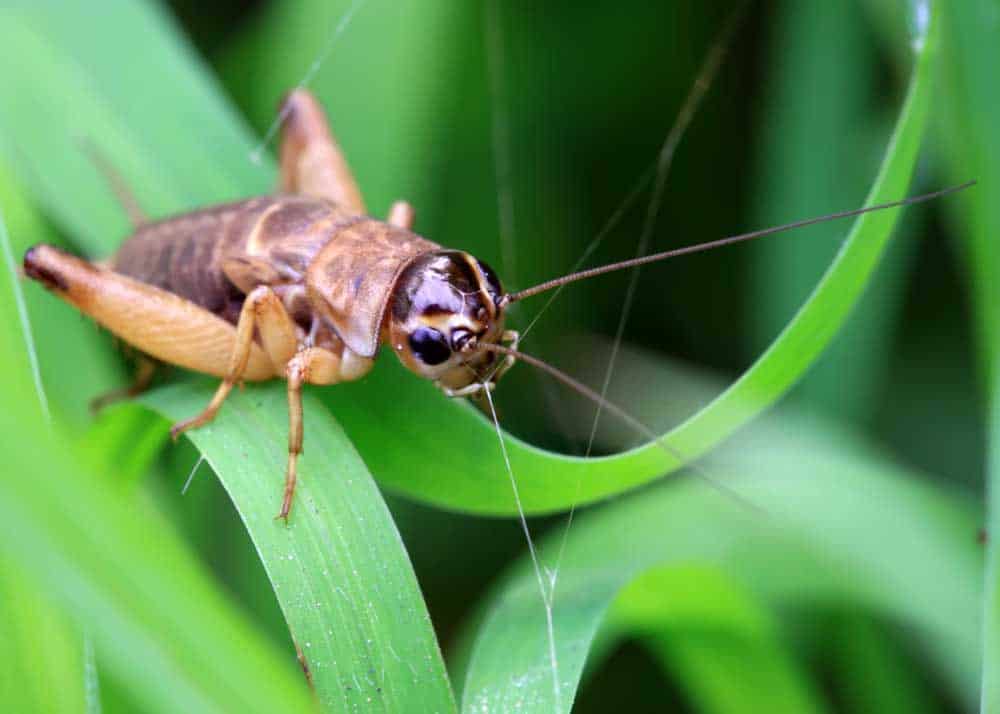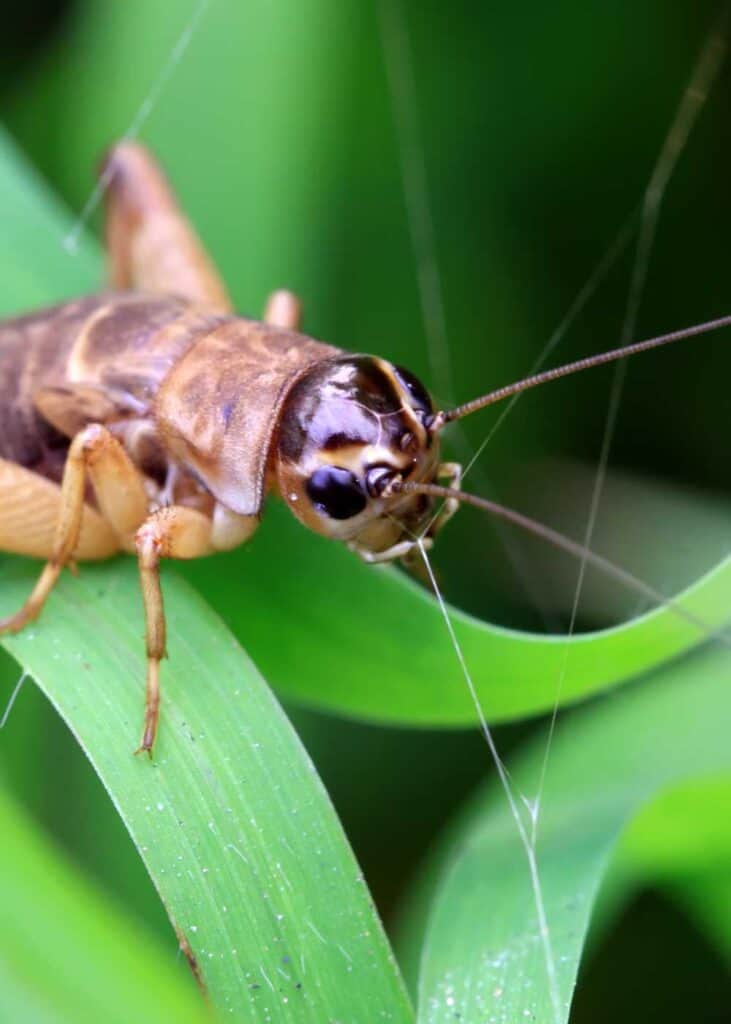Crickets are often the bane of your existence. While some find the noises they make soothing and even relaxing, many find that those noises drive them crazy and keep them from relaxing.
If you have a cricket problem on your hand, take a look at some of the easiest ways to trap those bugs in a cricket trap.

Table of Contents
3 Live Cricket Trap Ideas (Bait)
The simplest type of cricket trap is one that uses bait. You do not need to go to the store to buy supplies or spend a lot of money on items to make it because you can use things around the house.
1. Newspaper and Sugar/Bread
- Take a piece of newspaper and lay it flat on the ground.
- Mix equal parts granulated sugar and bread crumbs and then place the mixture on the newspaper.
- Cover it with another piece of newspaper.
- When you come back the next day, lift the paper and use an empty jar to catch the crickets. One of the nice things about this cricket trap is that you can replace the newspaper with towels and use any type of bread.
If you see a lot of crickets living outside, dig a hole in the ground that is deep enough to hide a glass or plastic jar.
You will then pour the bread and sugar mixture into the jar and place a towel or newspaper on top. Leave the trap sitting out all night. When you check on it in the morning, pull the newspaper off and immediately screw the lid onto the jar.
2. Soda Bottle with Sugar and Bread
Another live trap requires the use of a plastic bottle such as an empty two-liter of soda.
- Use a craft knife to carefully cut off the top of the bottle just above the label. You will then use the bread and sugar mixture in the bottom and turn the top of the bottle upside down.
- Insert it inside the bottle and place it in a spot where you see crickets.
- This cricket trap attracts the bugs who climb inside through the hole in the top, but they cannot get out and will remain stuck in the bottle until you empty it.
3. Cardboard Roll with Bait
There is also a cricket trap method that uses a cardboard roll such as a paper towel roll.
- Use an old roll that has no paper on it.
- Place a small amount of bait on a piece of newspaper that you put on a flat surface.
- Set the cardboard roll on top.
- The crickets will jump into the roll to eat the bait but cannot jump back out. To remove the crickets, cover the top of the roll with a piece of paper and carry it outside.
Another way to handle large cricket populations is to attract cricket predators. Here are 12 animals that eat crickets.
3 Lethal Cricket Traps
While some people catch crickets and release them in the wild or use them for fishing, others just want to get rid of the pesky bugs.
Lethal cricket traps use a combination of borax and granulated sugar. While wearing gloves to keep your hands safe from the borax, combine equal parts of the two ingredients and sprinkle the moisture on a shallow plate.
The crickets will eat the mixture and die. It can take several days before you see any results with this trap. You can use the same mixture with the plastic bottle trap, too.
As long as you have a shallow bowl or container, you can also use molasses or honey. Fill the bowl with enough water to cover the bottom and then add up to two tablespoons of the honey or molasses. When the crickets climb into the bowl to eat and drink, the molasses forms a sticky surface that traps them and causes them to drown.
Duct tape also works well at catching crickets. Simply place pieces of the tape in areas where you see crickets with the sticky side facing up.
The crickets will step on the tape and find that they cannot move. You can pick up the tape the next day and toss it in the trash.
Commercial Cricket Trap: Catchmaster Cricket XL
If you are overrun with crickets and just need to get rid of them, here’s what you need: Catchmaster Cricket XL.
The Catchmaster Cricket XL is the largest cricket trap available. It is safe to use (no poison). And it has 55 square inches of sticky catching area. Dimension is 5.25″ x 11″.
Placing Your Cricket Traps
Whether you choose live or lethal cricket traps, you need to know where to put them. Focus on the areas where you both see and hear the bugs.
Crickets are creatures of habit. Once they find a place to live, they seldom venture far from it.
Look for areas around your home that offer darkness and privacy such as bushes and gardens. You can put one or two traps in those spots to kill or catch the insects.
If you have one or more crickets in your home, you may find that they chirp at all hours and never seem to stop.
Crickets can come right through your front door or through any openings they find such as a gap between your window and its frame.
Place at least one cricket trap in each corner of your attic and basement and another beneath your refrigerator. It’s also helpful to set them inside your cabinets.
Choosing Your Cricket Bait
The best bait to use in your homemade trap is a combination of something sweet and a type of carb.
Though many like using bread and sugar, you can also use a type of sugary or sweet bread. Crumbs or dried bread usually work better than fresh bread does because it has a stronger scent that attracts them. If you don’t want to take a trip to the store just for breadcrumbs, make your own.
You can use a piece of bread that you let sit out for a few days or toss fresh bread into the oven at a low temperature to dry it out.
Crumble the bread to make the crumbs for your cricket trap. Knowing what crickets eat is key to catching them.
More Reading: How to Make a June Bug Trap

Learn more about crickets in our huge Camel Cricket Guide. What do you think? Are camel crickets dangerous?
Why struggle with the chirping of wild crickets running through your house and causing you to jump when they come out of nowhere? With any of these seven homemade cricket traps, you’ll find the perfect way to catch crickets or kill the ones wreaking havoc on your home.
- About the Author
- Latest Posts
Bryan Haines is a co-founder and writer at The Buginator. And is working to make it the best resource for taking back the outdoors from biting, stinging pests.
He also blogs about travel at Storyteller.Travel and photography at Storyteller Tech. Bryan is a partner at Storyteller Media, a publishing company he runs with his wife, Dena.


Chris
Friday 8th of September 2023
Thank you for the ideas to trap crickets. We were looking for a non-lethal approach to avoid poisoning our clowder of ferals and the inverted soda bottle trap fit the bill.